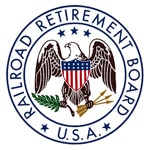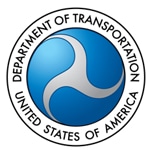
The following questions and answers describe the benefits payable to spouses and the eligibility requirements.
1. How are railroad retirement spouse annuities computed?
Regular railroad retirement annuities are computed under a two-tier formula. The spouse annuity formula is based on certain percentages of the employee’s Tier I and Tier II amounts.
The Tier I portion of an employee’s annuity is based on both railroad retirement credits and any social security credits that the employee also earned. Computed using social security benefit formulas, an employee’s Tier I benefit approximates the social security benefit that would be payable if all of the employee’s work were performed under the Social Security Act.
The Tier II portion of the employee’s annuity is based on railroad retirement credits only, and may be compared to the retirement benefits paid over and above social security benefits to workers in other industries.
The first Tier of a spouse annuity, before any applicable reductions, is 50 percent of the railroad employee’s unreduced Tier I amount. The second Tier amount, before any reductions, is 45 percent of the employee’s unreduced Tier II amount.
2. How does a railroad retirement spouse annuity compare to a social security spouse benefit?
The average annuity awarded to spouses in fiscal year 2014, excluding divorced spouses, was $1,050 a month, while the average monthly social security spouse benefit was about $614.
Annuities awarded in fiscal year 2014 to the spouses of employees who were of full retirement age or over and who retired directly from the rail industry with at least 25 years of service averaged $1,224 a month; and the average award to the spouses of employees retiring at age 60 or over with at least 30 years of service was $1,425 a month.
3. What are the age requirements for a railroad retirement spouse annuity?
The age requirements for a spouse annuity depend on the employee’s age and date of retirement and the employee’s years of railroad service.
If a retired employee with 30 or more years of service is age 60, the employee’s spouse is also eligible for an annuity the first full month the spouse is age 60. Certain early retirement reductions are applied if the employee first became eligible for a 60/30 annuity July 1, 1984, or later and retired at ages 60 or 61 before 2002. If the employee was awarded a disability annuity, has attained age 60 and has 30 years of service, the spouse can receive an unreduced annuity the first full month she or he is age 60, regardless of whether the employee annuity began before or after 2002 as long as the spouse’s annuity beginning date is after 2001.
If a retired employee with less than 30 years of service is age 62, the employee’s spouse is also eligible for an annuity the first full month the spouse is age 62. Early retirement reductions are applied to the spouse annuity if the spouse retires prior to full retirement age. Full retirement age for a spouse is gradually rising to age 67, just as for an employee, depending on the year of birth. Reduced benefits are still payable at age 62, but the maximum reduction will be 35 percent rather than 25 percent by the year 2022. However, the Tier II portion of a spouse annuity will not be reduced beyond 25 percent if the employee had any creditable railroad service before Aug. 12, 1983.
4. What if the spouse is caring for a child of the retired employee?
A spouse of an employee receiving an age and service annuity (or a spouse of a disability annuitant who is otherwise eligible for an age and service annuity) is eligible for a spouse annuity at any age if caring for the employee’s unmarried child, and the child is under age 18 or a disabled child of any age who became disabled before age 22.
5. What are some of the other general eligibility requirements?
The employee must have been married to the spouse for at least one year, unless the spouse is the natural parent of their child, or the spouse was eligible or potentially eligible for a railroad retirement widow(er)’s, parent’s or disabled child’s annuity in the month before marrying the employee or the spouse was previously married to the employee and received a spouse annuity. However, entitlement to a surviving divorced spouse, surviving divorced young mother (father), or remarried widow(er) annuity does not waive the one-year marriage requirement.
6. Can the same-sex spouse of a railroad employee file for a railroad retirement spouse annuity?
On June 26, 2013, the Supreme Court found Section 3 of the Defense of Marriage Act, which prevented the Federal government from recognizing marriages of same-sex couples, to be unconstitutional. As a result, the Railroad Retirement Board (RRB) now accepts applications for benefits from those eligible spouses in same-sex marriages.
Applicants should be aware that the Railroad Retirement Act requires that in determining whether an applicant is the spouse of the railroad employee, the RRB must use the rules for determining relationship for benefit entitlement purposes under the Social Security Act. In general, that Act requires that the Social Security Administration refer to State law. Accordingly, the RRB will determine whether an applicant is a spouse under the same conditions as the Social Security Administration.
7. Are spouse annuities subject to offset for the receipt of other benefits?
The Tier I portion of a spouse annuity is reduced for any social security entitlement, regardless of whether the social security benefit is based on the spouse’s own earnings, the employee’s earnings orthe earnings of another person. This reduction follows principles of social security law which, in effect, limit payment to the higher of any two or more benefits payable to an individual at one time.
The Tier I portion of a spouse annuity may also be reduced for receipt of any Federal, State or local pension separately payable to the spouse based on the spouse’s own earnings. The reduction generally does not apply if the employment on which the public service pension is based was covered under the Social Security Act throughout the last 60 months of public employment. Most military service pensions and payments from the Department of Veterans Affairs will not cause a reduction. Pensions paid by a foreign government or interstate instrumentality will not cause a reduction. For spouses subject to a public service pension reduction, the tier I reduction is equal to 2/3 of the amount of the public service pension.
In addition, if the employee was first eligible for a railroad retirement annuity and a federal, state or local government pension after 1985, there may be a reduction in the employee’s Tier I amount for receipt of a public pension based, in part or in whole, on employment not covered by social security or railroad retirement after 1956. If the employee’s Tier I benefit is offset for a noncovered service pension, the spouse Tier I amount is 50 percent of the employee’s Tier I amount after the offset.
The spouse Tier I portion may also be reduced if the employee is under age 65 and is receiving a disability annuity as well as worker’s compensation or public disability benefits.
While these offsets can reduce or even completely wipe out the Tier I benefi
t otherwise payable to a spouse, they do not affect the Tier II benefit potentially payable to that spouse.
8. Under what conditions can the divorced spouse of a rail employee receive a spouse annuity?
A spouse annuity may also be payable to the divorced wife or husband of a retired employee if their marriage lasted for at least 10 consecutive years, both have attained age 62 for a full month, and the divorced spouse is not currently married. A divorced spouse can receive an annuity even if the employee has not retired, provided they have been divorced for a period of not less than 2 years, the employee and former spouse are at least age 62, and the employee is fully insured under the Social Security Act using combined railroad and social security earnings. The amount of a divorced spouse’s annuity is, in effect, equal to what social security would pay in the same situation and therefore less than the amount of the spouse annuity otherwise payable (Tier I only). The average divorced spouse annuity awarded in fiscal year 2014 was $624.
9. Would the award of an annuity to a divorced spouse affect the monthly annuity rate payable to a retired employee and/or the current spouse?
No. If a divorced spouse becomes entitled to an annuity based on the employee’s railroad service, the award of the divorced spouse’s benefit would not affect the amount of the employee’s annuity, nor would it affect the amount of the railroad retirement annuity that may be payable to the current spouse.
10. What if an employee and spouse are both railroad employees?
If both the employee and spouse are qualified railroad employees and either had some railroad service before 1975, both can receive separate railroad retirement employee and spouse annuities, without a full dual benefit reduction. If both started railroad employment after 1974, the amount of any spouse or divorced spouse annuity is reduced by the amount of the employee annuity to which the spouse is also entitled.
11. Are railroad retirement annuities subject to garnishment or property settlements?
Certain percentages of any railroad retirement annuity (employee, spouse or survivor) may be subject to legal process (i.e., garnishment) to enforce an obligation for child support and/or alimony payments.
Also, a court-ordered partition payment may be paid even if the employee is not entitled to an annuity provided that the employee has 10 years of railroad service or five years after 1995 and both the employee and former spouse are 62.
Employee Tier II benefits, vested dual benefits and supplemental annuities are subject to court-ordered property settlements in proceedings related to divorce, annulment or legal separation. Tier I benefits are not subject to property settlements.
12. How can a person get more information about railroad retirement spouse annuities?
For more information and/or a benefit estimate, contact an office of the RRB by calling toll free at (877) 772-5772. Most RRB offices are open to the public from 9 a.m. to 3:30 p.m., Monday through Friday, except on Federal holidays. Visit the agency’s website at www.rrb.gov.
 The start of a new year is the time for resolutions. Railroad retirees covered under Medicare can receive the help they need in making some of their resolutions a reality.
The start of a new year is the time for resolutions. Railroad retirees covered under Medicare can receive the help they need in making some of their resolutions a reality. The Union Plus Scholarship Program is once again offering up scholarships ranging from $500 to $4,000 to help union members and their children attend college. These one-time cash awards are for study beginning in the Fall each year and students may re-apply every year that they are enrolled in school. The deadline to apply for the 2015 scholarship is Saturday, Jan. 31, 2015, at 12 p.m. (eastern time).
The Union Plus Scholarship Program is once again offering up scholarships ranging from $500 to $4,000 to help union members and their children attend college. These one-time cash awards are for study beginning in the Fall each year and students may re-apply every year that they are enrolled in school. The deadline to apply for the 2015 scholarship is Saturday, Jan. 31, 2015, at 12 p.m. (eastern time).  President Barack Obama has renominated Therese McMillan as the next administrator of the Federal Transit Administration (FTA) after the U.S. Senate failed to act on her nomination in the last Congress.
President Barack Obama has renominated Therese McMillan as the next administrator of the Federal Transit Administration (FTA) after the U.S. Senate failed to act on her nomination in the last Congress. SOMERVILLE, Mass. – U.S. Transportation Secretary Anthony Foxx announced a $996 million federal grant agreement to extend Massachusetts Bay Transportation Authority (MBTA) Green Line light rail service from East Cambridge to Somerville and Medford. The extension will provide faster and more efficient travel to jobs in downtown Boston and will serve some of the region’s most densely populated communities. Secretary Foxx and Acting Federal Transit Administrator Therese McMillan participated in a ceremony to commit the funds with Governor Deval Patrick, Senator Elizabeth Warren, Congressman Michael Capuano, representatives from the Massachusetts Department of Transportation (MassDOT) and MBTA, and other officials.
SOMERVILLE, Mass. – U.S. Transportation Secretary Anthony Foxx announced a $996 million federal grant agreement to extend Massachusetts Bay Transportation Authority (MBTA) Green Line light rail service from East Cambridge to Somerville and Medford. The extension will provide faster and more efficient travel to jobs in downtown Boston and will serve some of the region’s most densely populated communities. Secretary Foxx and Acting Federal Transit Administrator Therese McMillan participated in a ceremony to commit the funds with Governor Deval Patrick, Senator Elizabeth Warren, Congressman Michael Capuano, representatives from the Massachusetts Department of Transportation (MassDOT) and MBTA, and other officials.